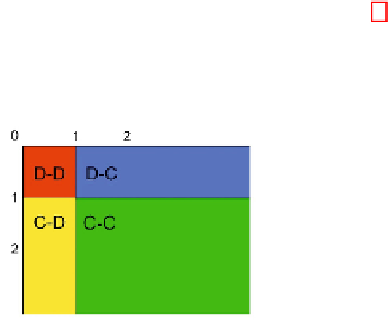Information Technology Reference
In-Depth Information
Red (resp. green) areas in Figures represent the fact that agents in these interval
always play the strategy profile D,D (resp. C,C).
Harsanyi's Ideality
We first use Harsanyi's algorithm of ideality in order to compute the agent's modified
utility function
U
∗
. For this first simulation, we keep all the experiment parameters
at their default values. We can observe results in the following Figure 1, it represents
the convergent behavior of agents on vertical axe (
i
) interactions with agents on the
horizontal one (
j
).
Fig. 1.
Harsanyi's ideality results
For Harsanyi's case, there are not very remarkable results. However, we shall note
that high guilt aversion does not 'pay off'. On the contrary, less guilt averse agents
have a higher average payoff (indeed, guilt averse agents interacting with guilt seeking,
get 'cheated on' and their average payoff is the 'sucker' one, that is, zero; whilst their
opponent benefits from their defection and obtains the maximum payoff, three).
Furthermore, when implementing Harsanyi's ideality algorithm, the learning process
implemented in the agent is not involved into the decision-making process. Indeed, it
is easy to see that if an agent has a degree of guilt aversion lower than one, in the
game with transformed utility
U
∗
the agent's strategy
D
strongly dominates the agent's
strategy
C
. Therefore, for every possible probability distribution over the opponent's
strategy,
D
is the strategy which maximizes the agent's expected utility. On the contrary,
if an agent has a degree of guilt aversion higher than one, in the game with transformed
utility
U
∗
the agent's strategy
C
strongly dominates the agent's strategy
D
. Therefore,
for every possible probability distribution over the opponent's strategy,
C
is the strategy
which maximizes the agent's expected utility. Hence, an agent with degree of guilt
aversion lower than one will always play
D
, whereas an agent with degree of guilt
aversion higher than one will always play
C
. Agents with degree of guilt aversion equal
to one are exactly in the co-joint point where the expected utilities of the two strategies
C
and
D
are always equal (i.e., the expected utilities of
C
and
D
for an agent with degree
of guilt aversion equal to one are equal, for every possible probability distribution over
the opponent's strategy). Thus, an agent with degree of guilt aversion equal to one will
always play in a random way.

